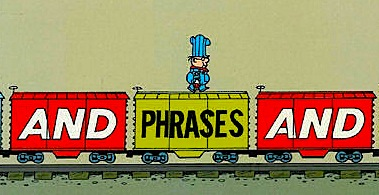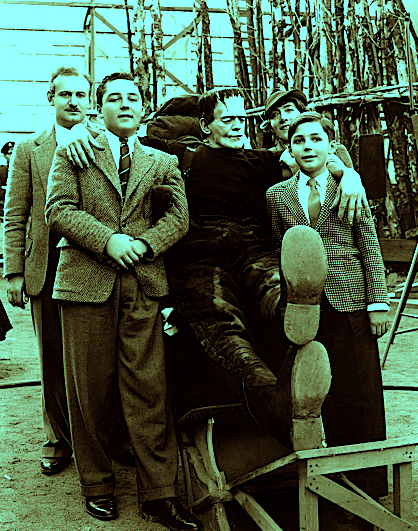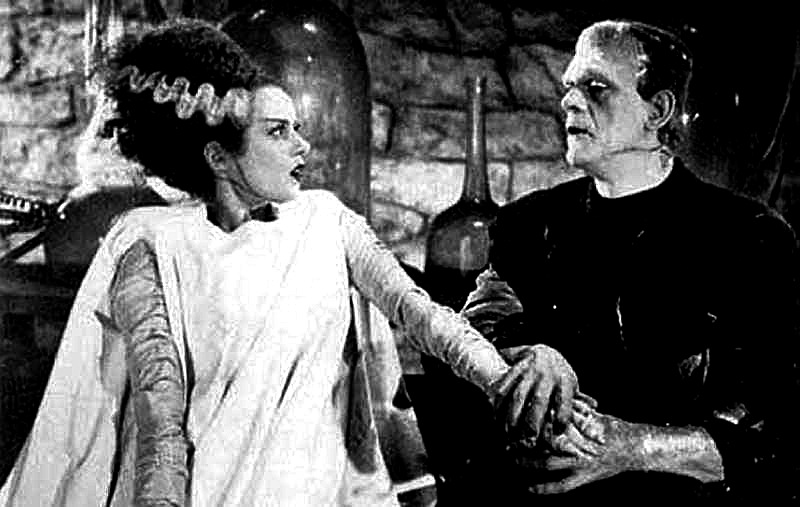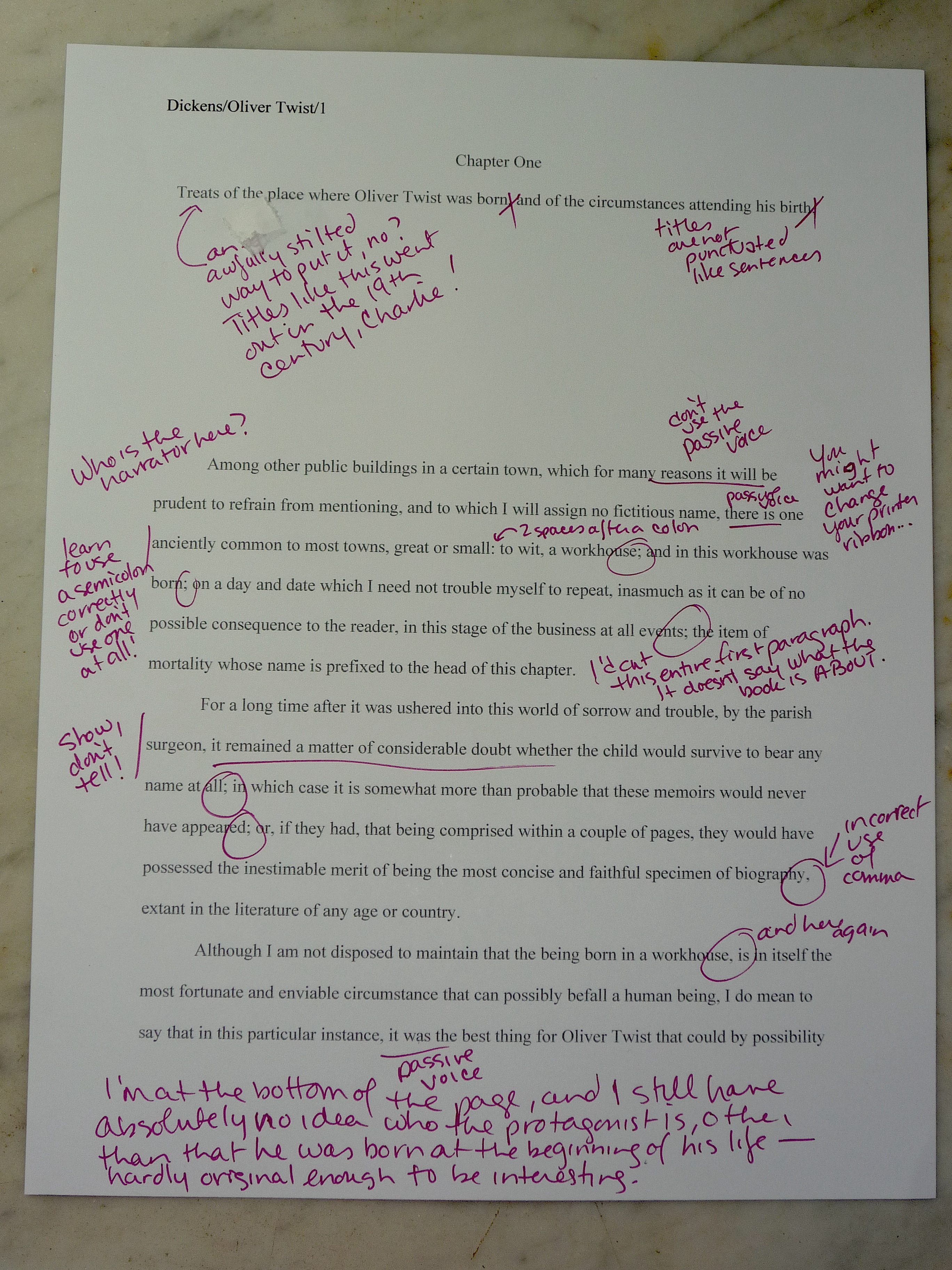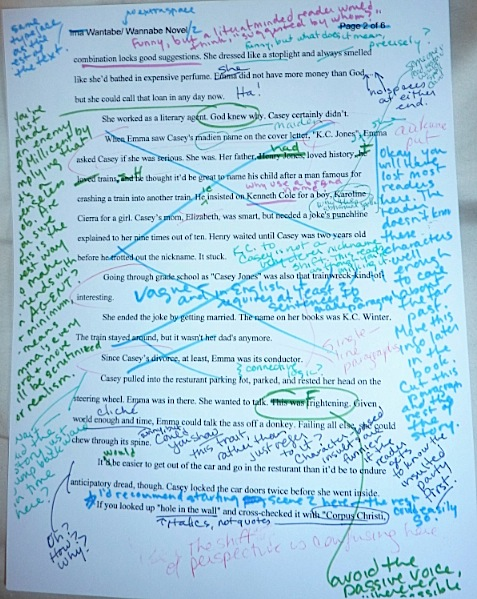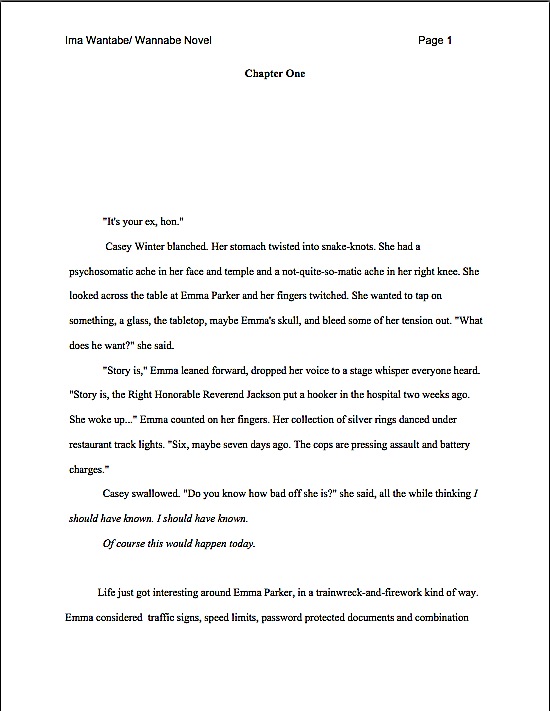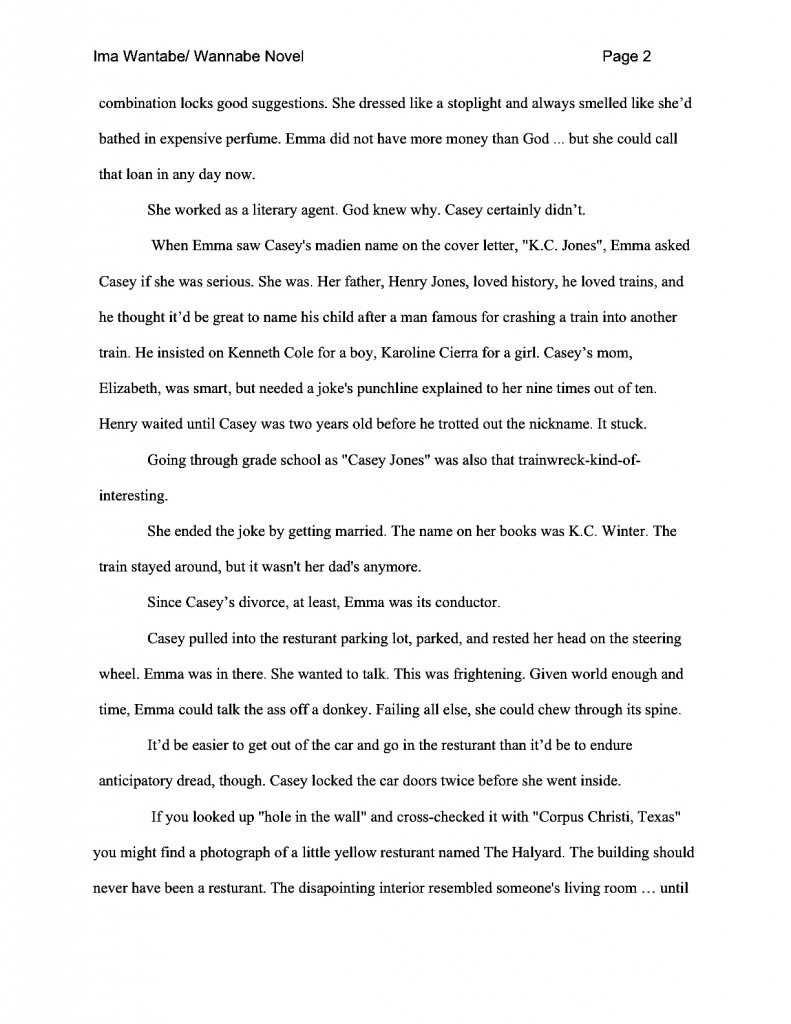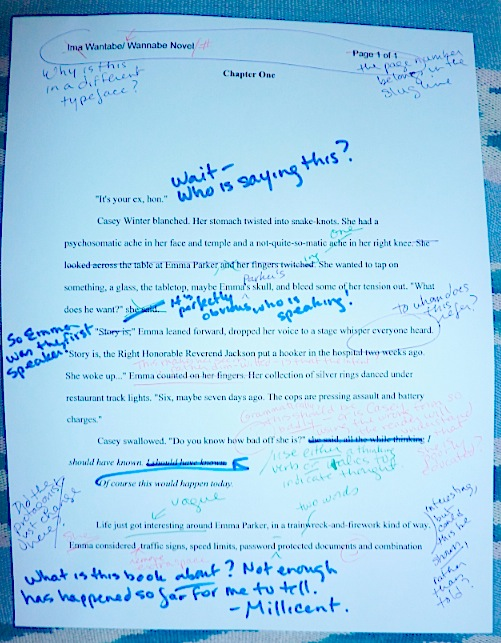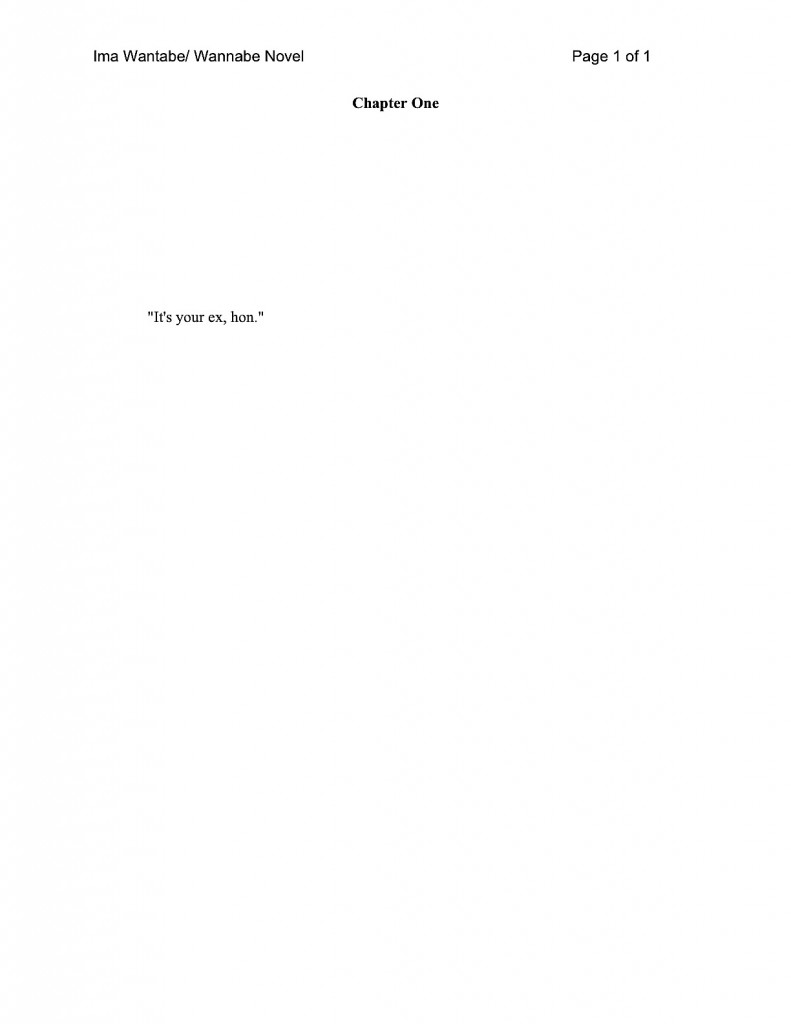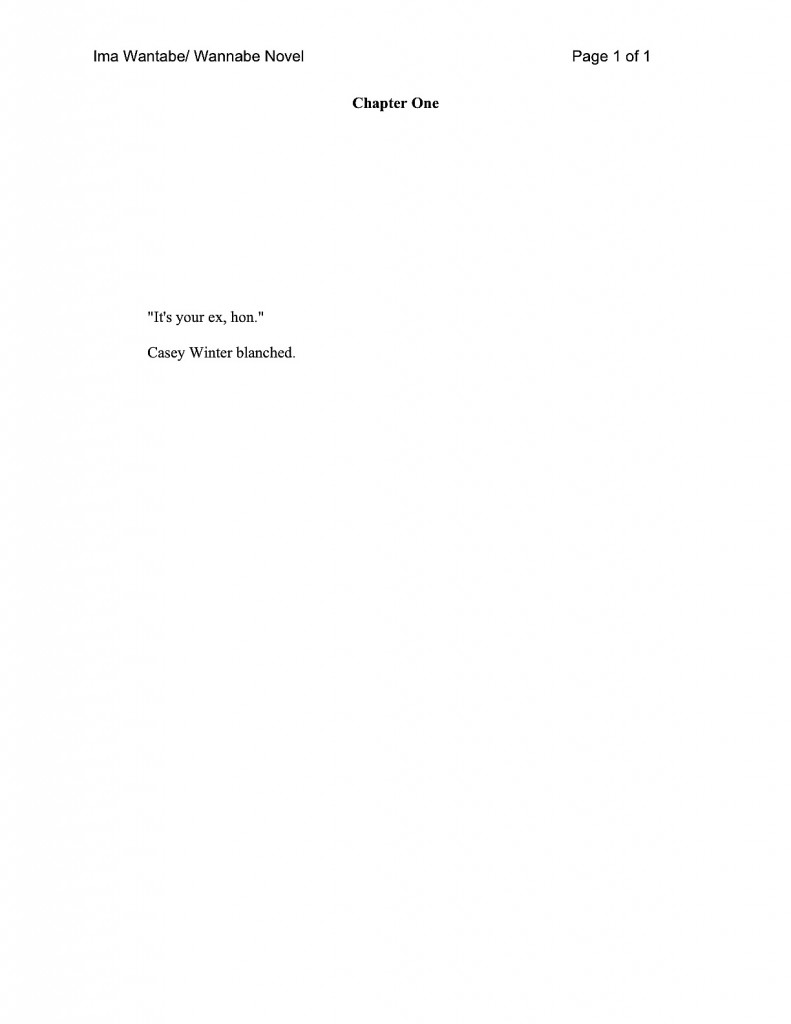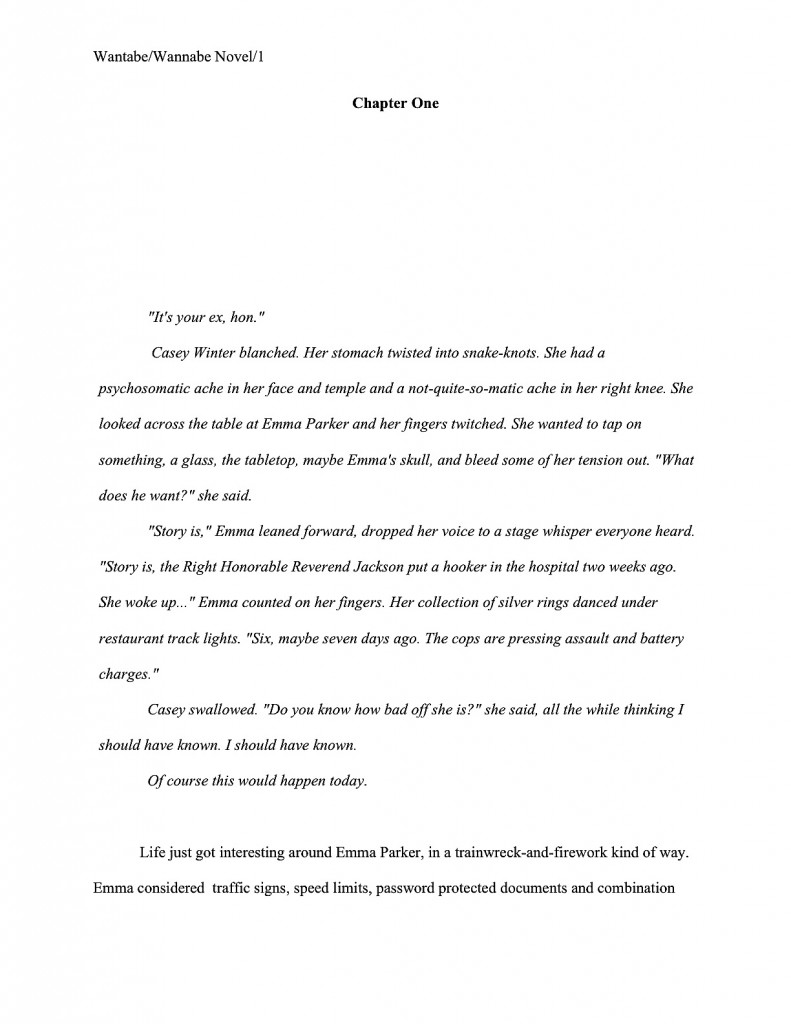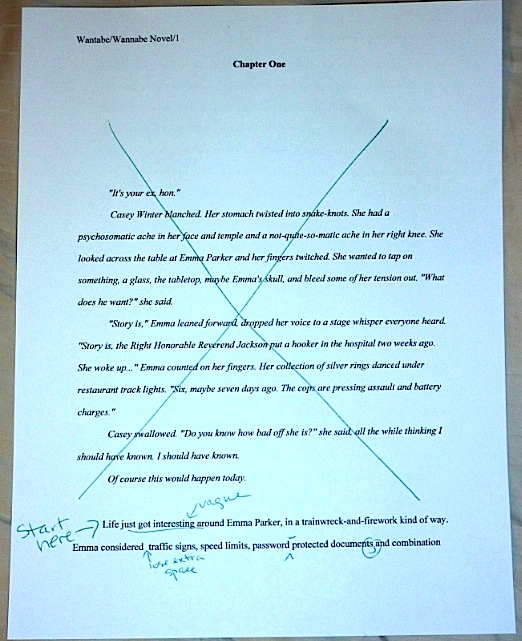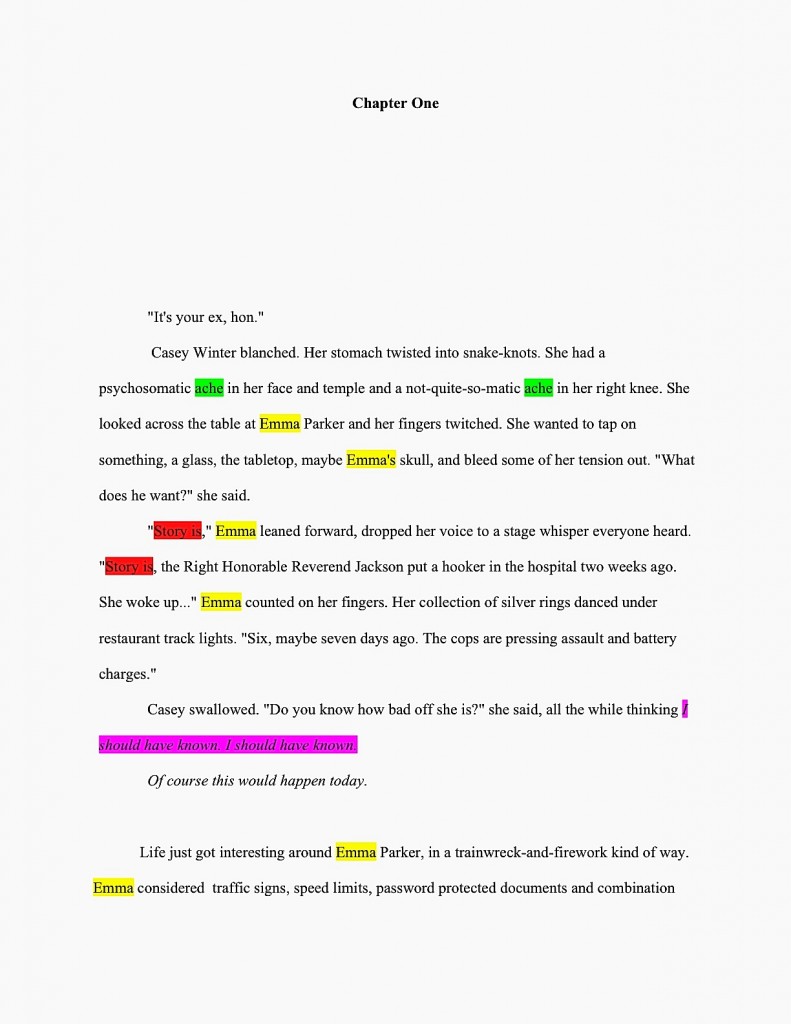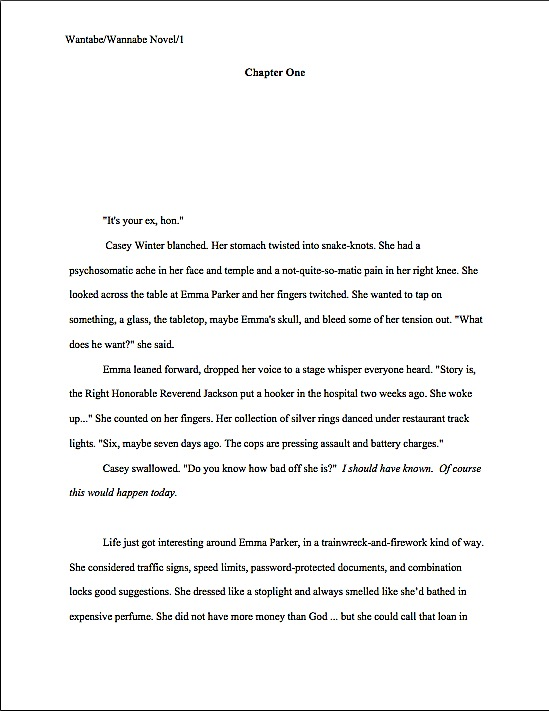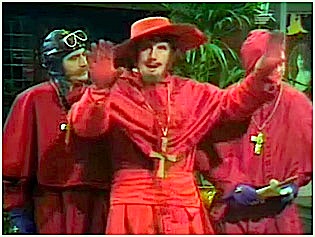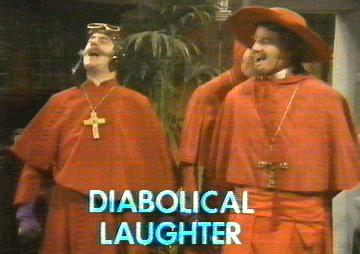
Three guesses: which particular species of word repetition am I going to tackle in today’s post?
No, but seriously, folks, you’d be astonished at just how often a given character’s name will pop up within a single page of text in the average manuscript submission — and even more astonished at how difficult it is for chronic name-repeaters to spot the problem in their own writing. Like the bugbear of our last few posts, the ubiquitous and, major characters’ names seem to become practically invisible to self-editing writers.
Which prompts me to ask: everyone did catch the plethora of Johns in today’s title, right?
I should hope so, now that you’ve been sharpening your eye throughout this series on revising Frankenstein manuscripts. But are you as good at spotting the problem in its native environment?
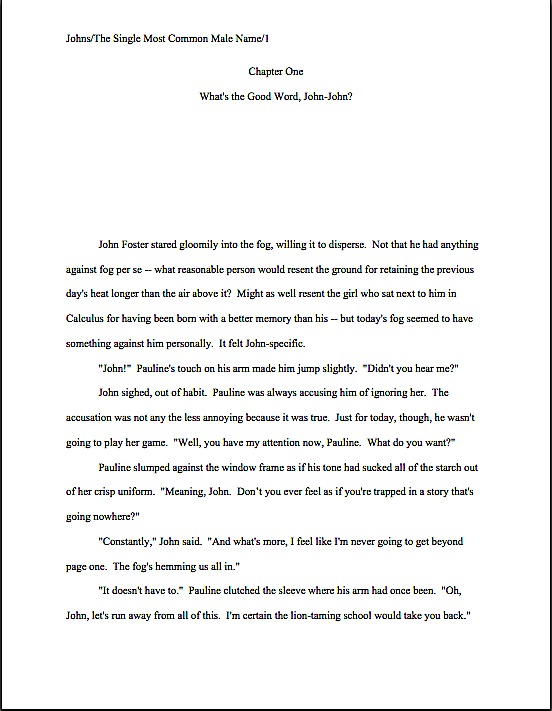
How did you do? Award yourself a gold star if you spotted all 9 iterations of John in the body of the text — and another if you caught it in the header. (No, that wouldn’t count as repetition in the text, now that you mention it, but to a repetition-weary Millicent at the end of a long day of screening manuscript submissions, it might contribute subconsciously to her sense of being bombarded by Johns. She’s only human, you know.)
But let me ask you: did the 5 Paulines bug you at all? Or did they simply fade into the woodwork, because your brain automatically accepted them as necessary to the text?
If you’re like 99.99% of the reading public, the repetition of Pauline’s name probably didn’t strike you as at all unusual, but to that other .01% — a demographic that includes practically everyone who has ever read for a living, including agents, editors, and contest judges — it might well have been distracting. Amongst Millicents, submissions (and first drafts in general) are notorious for this type of redundancy.
Also notorious in her circles: the overuse of the character name John in general. Writers just love our pal John, apparently. As a group, we also have a practically unbounded affection for Jon and Jack.
News flash: proper nouns are as susceptible to over-use in writing as any other kind of words. Although aspiring writers’ eyes often glide over character and place names during revision, thinking of them as special cases, is no such thing as a word exempt from being counted as repetitive if it pops up too often on the page.
In fact, proper noun repetition is actually more likely to annoy a garden-variety Millicent than repetition of other nouns. (Did you catch how frequently fog appeared in that last example, by the way?) Today, we’re going to talk about why too-frequent repetition of the character and place names makes the average editor rend her garments and the garden-variety agent moan.
If it’s any consolation, they’ve been rending and moaning for years; proper nouns have been asserting and re-asserting themselves on the manuscript page for a couple of decades now. Pros used to attribute this problem to the itsy-bitsy computer screens that writers were working upon — remember the early Macs, with those postcard-sized screens? They weren’t even tall enough to give a life-sized reflection of an adult face. If the user made the text large enough to read, the screen would only hold a dozen or so lines.
But as technology has progressed, the screens on even inexpensive computers have gotten rather large, haven’t they? Even on a laptop, you can usually have a view of half a page, at least. My extra-spiffy editor’s monitor can display two full-sized manuscript pages side by side. I could serve a Thanksgiving dinner for 8 upon it, if I so chose.
All of which begs the question: given how much easier it is to see words on a screen than in days of yore, why is it that writers so seldom have a clear idea of how distracting name repetition can be on a printed page? Is it merely that writers christen their major characters with their favorite names (including John, as likely as not), and want to see them in print again and again?
Not entirely. Partially, I think, it has to do with how differently the eye reads text on a backlit screen: it definitely encourages skimming, if not great big leaps down the page. But for the most part, I believe it has to do with how infrequently writers read their own work in hard copy.
Hear that Gregorian-like chanting floating through the ether? That’s every writer for whom I’ve ever edited so much as a paragraph automatically murmuring, “Before submission, I must read my manuscript IN ITS ENTIRETY, IN HARD COPY, and OUT LOUD.”
Yes, yes, I know: I MAY have mentioned this two or three thousand times before. I repeat this advice so often that writers who read this blog religiously have been heard to mutter this inspiring little rule of thumb unconsciously their sleep, under their breath during important meetings, on their deathbeds…
So yes, I admit it: I’m a broken record on this subject. But for some very, very good reasons, I assure you.
To name but the two most relevant for Frankenstein manuscript-revision purposes: first, reading in hard copy makes patterns in the text far more apparent to the reading eye than scanning text on a backlit screen. Hard copy is also how almost any editor, most agents, and practically every contest judge will be seeing your submissions.
Yes, even in this advanced electronic age. Many agencies still don’t accept e-mailed submissions; neither do most editors at publishing houses. The major literary contests for aspiring writers have been quite slow to switch over to purely electronic entries (probably because regular mail submissions are very handy for sending the admission fee).
Ready to invest some serious thought into how often character names appear on the pages of your manuscript, particularly the opening pages? Well, you’re partially out of luck: as much as I would like to perform a vivid compare-and-contrast demonstration, because you and I communicate electronically, I can’t show you the same page on screen and off.
Fortunately for illustrative purposes, however, proper nouns are unusually gifted at flagging down a reader’s attention. See if you can spot why.
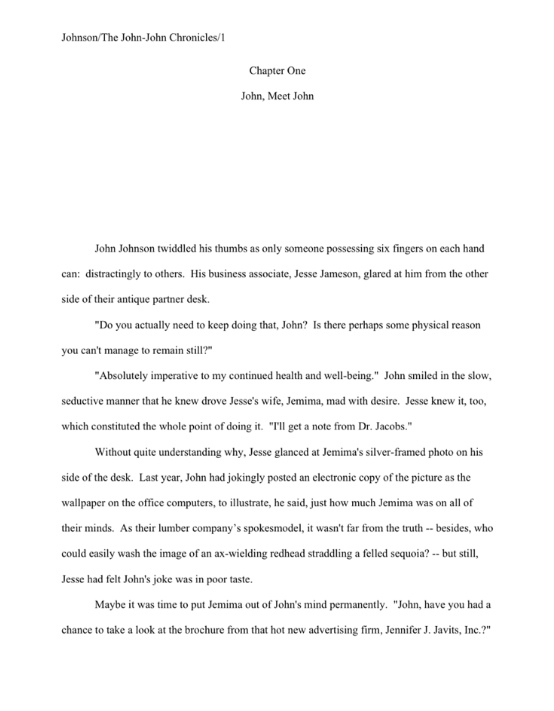
See how your eye tries to leap from one J to the next? Come a little closer, and I let you in on a closely-held professional readers’ secret: the skimming eye is automatically attracted to capital letters in a text.
That’s why, in case you were wondering, not-especially-literate people tend to Capitalize Words for Emphasis. (When they’re not placing words that no one has ever said aloud inside quotation marks — another widespread professional readers’ pet peeve.) It’s almost always grammatically incorrect, but it definitely does the job of soliciting attention.
Due to proper nouns’ completely legitimate use of capitals, they jump off the page at the reader — which can be a good thing, if a manuscript is crammed to the gills with action, unnamed characters, and other literary titivations that do not involve the major characters. The reader’s eye will be drawn to the major players when they show up. Problem solved, right?
Not in most manuscripts, no. Since most novels and pretty much all memoirs deal with their respective protagonists on virtually every page, it isn’t precisely necessary to keep calling attention to the protagonist by referring to him by name.
Or is it, John? John? Are you listening, John?
Frequent repetition of the protagonist’s name is seldom necessary, especially in scenes where only he appears — and it can become downright irritating over the course the dialogue of a two-character scene. Unless the one of the characters happens to have multiple personalities, it’s generally assumed that the names of the conversants will not alter substantially within the course of a few pages of dialogue. So why keep labeling the participants, in a scene where there’s little probability of confusing the reader?
That’s why professional editors so often excise tag lines (he said, she said), rather than having the narrative identify every speaker ever time s/he opens his or her pretty mouth: with only two possible speakers and alternating dialogue, any reasonably intelligent reader may be relied upon to follow which lines of dialogue are being spoken by which character. That reasonably intelligent reader is also more than capable of remembering what both of those people are called by their kith and kin, once the narrative has established proper names.
But you’d never know that by the number of times some manuscripts have their discussants call one another by name — and how often the narrative refers to them by name.
In many manuscripts, simply reducing the number of tag lines in a dialogue scene will cut out most of the name repetition. In dialogue where the use of tag lines has not been minimized, proper names can pop up so frequently that it’s like a drumbeat in the reader’s ear. Take a gander:
“I don’t think that’s fair of you, April,” Louisa snapped.
“Why ever not?” April asked.
“Oh, don’t be disingenuous with me, April. I’ve known you too long.”
April played with a nearby paperweight. Was she testing its weight for throwing? “Honestly, Lou, I haven’t the slightest idea what you’re talking about. Unless this is about John?”
“Of course it’s about John,” Louisa huffed. “How many husbands do you think I have?”
“Just one,” April said, smiling. “It’s been just John since the seventh grade.”
Louisa’s eyes stung for a moment. April always had known how to push her buttons. “Don’t change the subject, April. Next, you’ll be reminiscing about that time we hanged our classmate when we were in the fourth grade.”
April sighed. “Those were the days, eh, Lou?”
“I’ll say,” Louisa said, edging out of paperweight-tossing range. “She should have known better than to beat you at tetherball.”
Yes, speakers in the real world do call one another by name this much sometimes, but like so much of real-life dialogue, that level of repetition would be snore-inducing, if not downright hypnotic, on the page. Especially when name-bearing tag lines are featured in the text, even dialogue between just a couple of characters can convey the sense of a very crowded room.
And that’s more than a little puzzling to professional readers: why, we wonder, would a writer go to such lengths to label people the reader already knows?
Even when both characters share the same sex, and thus the same personal pronoun, constant name repetition is rarely necessary for maintaining clarity. Yet over-labeling is so common that after reading a few hundred — or a few thousand — manuscripts, Millicent would have to be pretty unobservant not to have begun to suspect that many writers simply harbor a prejudice against the innocent-but-effectual pronouns he and she.
Seriously, a lot of submitters seem to go out of their way to eschew pronouns, even in narrative paragraphs. To take not an unusually proper noun-ridden example:
Eve slapped her laptop shut with a bang and glanced around, annoyed, for her waitress. Naturally, Tanya was nowhere in sight. Eve ostentatiously drained her drink to its dregs, but when Tanya did not come running, Eve filched a straw from the table next to her. The guy tapping away on his laptop never even noticed. Eve made slurping sounds on the bottom of her glass with it.
Still no sign of Tanya. For good measure, Eve upended the glass, scattering swiftly melting ice cubes messily all over the starched white tablecloth, and began banging the now-empty vessel upon the now-sodden linen. “Service!” Eve bellowed. “Tanya!”
Quietly, Tanya retrieved Eve’s glass from Eve’s waving hand. “Don’t you think you’ve had enough?”?
Eve looked up at Tanya with that my-daddy-is-someone-important air that always worked with bank tellers, hot dog vendors, and waitresses who lived primarily upon their tips. “I’ve been drinking Perrier all night. As you would know if you had been paying attention, Tanya. May I have another?”
Come on, admit it — that was kind of annoying to read, wasn’t it? Until you’ve seen this phenomenon in action, it seems a trifle counter-intuitive that reusing a single word within two consecutive lines might be irritating to a reader, but it can be, even if the word in question is not a proper noun. The capitalization of a name makes it stand out more, however.
Want to see a deceptively simple revision that would render that last example infinitely more annoying to read? Look what happens when I rechristen Eve and Tanya with names beginning with the same capital letter.
Eve slapped her laptop shut with a bang and glanced around, annoyed, for her waitress. Naturally, Edna was nowhere in sight. Eve ostentatiously drained her drink to its dregs, but when Edna did not come running, Eve filched a straw from the table next to her. The guy tapping away on his laptop never even noticed. Eve made slurping sounds on the bottom of her glass with it.
Still no sign of Edna. For good measure, Eve upended the glass, scattering swiftly melting ice cubes messily all over the starched white tablecloth, and began banging the now-empty vessel upon the now-sodden linen. “Service!” Eve bellowed. “Edna!”
Quietly, Edna retrieved Eve’s glass from Eve’s waving hand. “Don’t you think you’ve had enough?”
Eve looked up at Edna with that my-daddy-is-someone-important air that always worked with bank tellers, hot dog vendors, and waitresses who lived primarily upon their tips. i’ve been drinking Perrier all night. As you would know if you had been paying attention, Edna. May I have another?”
Remarkable, isn’t it? To get an even better sense of how repetitious it would seem on a printed page, take a few steps back from your computer (if you can manage that logistically) and take a gander at the pattern all of those capital Es make in the text.
Distracting, no?
Now, admittedly, the writer of this exceptional excerpt may merely have been trying to clarify matters by repeating the names so often: there are in fact two women in this scene. If both were only called she every time, naturally, the narrative might conceivably become confusing. (If you have any doubts about how confusing a narrative can be when no proper names are used at all, get a 4-year-old to tell you the plot of a movie she’s just seen.)
However, like many proper name-heavy manuscripts, the writer here (who was me, obviously, so I guess it’s not all that productive to speculate about her motivation) has constructed the narrative to make opportunities for name repetition where it isn’t logically necessary. Here’s the same scene again, streamlined to minimize the necessity of naming the players:
She slapped her laptop shut with a bang and glanced around, annoyed, for her waitress. Naturally, Tanya nowhere in sight. Eve ostentatiously drained her drink to its dregs, but when no one came running, she filched a straw from the table next to her — the guy tapping away on his computer never even noticed — and made slurping sounds on the bottom of her glass with it.
Still no sign of life. For good measure, she upended the glass, scattering swiftly melting ice cubes messily all over the starched white tablecloth, and began banging the now-empty vessel upon the now-sodden linen. “Service!” she bellowed.
Quietly, Tanya retrieved the now-airborne glass before it could crash to the floor. “Don’t you think you’ve had enough?”
Eve looked up at her with that my-daddy-is-someone-important air that always worked with bank tellers, hot dog vendors, and waitresses. “I’ve been drinking Perrier all night, as you would have known had you been paying attention. May I have another?”?
Anybody confused? I thought not. As you may see, proper nouns were not necessary very often in this excerpt.
Before any of you proper noun-huggers out there start grumbling about the care required to tell when a pronoun is appropriate and when a proper noun, that was not a very time-consuming revision; all it really required to alert the reader to which she was which was a clear narrative line, a well-presented situation — and a willingness to name names when necessary.
That, and an awareness that repeating names even as far apart as three or four lines just doesn’t look good on a printed page; it’s distracting to the eye, and therefore a detriment to the text. A proper noun repeated more than once per sentence, or within a single line of text, always seems just a little odd to a reader — and more than a little annoying to Millicent.
Ready to accept the general principle, but unsure how you might apply it to your Frankenstein manuscript? Never fear — next time, I shall run you through so many practical examples that you’ll be excising proper nouns in your sleep.
I thought you might enjoy some variation from the IN ITS ENTIRETY, IN HARD COPY, and OUT LOUD song. Night-night, John-John, and keep up the good work!

